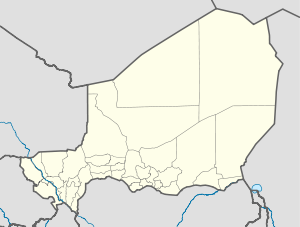Bilabrin
Bilabrin | |
|---|---|
| Coordinates: 14°25′41″N 13°25′18″E / 14.42806°N 13.42167°E | |
| Country | Niger |
| Region | Diffa Region |
| Department | N'guigmi Department |
| Commune | Nguigmi |
Bilabrin (also spelled Bélabirim, Bélabirin, Bilaberim, Bilabrim, Bilabrine, Boulabirina, Boula Brin, Boulabrin) is a village located in the commune of N'guigmi, Diffa Region, in southeast Niger. The village is approximately six kilometers west of the Chad–Niger border.
Bilabrin is the birthplace of former Niger President Mohamed Bazoum.[1]
Geography
[edit]The village is located north of Lake Chad at an altitude of 285 meters,[2] approximately six kilometers west of the international border with Chad. The city of N'guigmi, capital of the surrounding of N'guigmi commune of the same name, is located 37 kilometers southwest of Bilabrin.
Bilabrin lies in the transition zone between the Sahara and the Sahel. The village receives between 200 and 300 mm of annual rainfall per year.[3]
Population
[edit]Bilabrin recorded a population of 838 residents in 181 households in the 2001 Nigerien census.[4] That marked a population increase from the 1988 census, which registered a village population of 260 residents living in 66 households.[5]
History
[edit]French adventurer Stéphane Desombre stopped in Bilabrin in 1937 during his north to south crossing of the Sahara Desert.[6]
The Islamic terrorist group Boko Haram, which is based in neighboring northeast Nigeria, staged attacks in Bilabrin on 29-30 October 2019, which killed twelve Nigerien soldiers and wounded eight others.[7] A second Boko Haram attack on the night of 18-19 May 2020 also killed twelve Nigerien soldiers and wounded approximately twenty people.[8]
Notable residents
[edit]Former President of Niger Mohamed Bazoum, who is a member of the Ouled Slimane people, was born in Bilabrin in 1960.[1]
References
[edit]- ^ a b "Featured Speaker: Mohamed Bazoum, President of the Republic of Niger". World Bank. 2023-03-30. Archived from the original on 2023-04-20. Retrieved 2023-08-03.
- ^ Julien Rechenmann (1966), Catalogue des stations gravimétriques réoccupables en Afrique Occidentale. Mesures effectuées de 1953 à 1965 (PDF), Bondy: ORSTOM, p. 107, retrieved 2022-10-09
- ^ Damien Hauswirth, Hassane Yayé, Abdoulaye Sambo Soumaila, Badamassi Djariri, Issaka Lona, Malam Boukar Abba (2020), Appui à la formulation concertée de la SPN2A pour la République du Niger. Identification et évaluation des options d'agriculture intelligente face au climat prioritaires pour l'adaptation face aux changements climatiques au Niger (PDF), vol. 2 : Annexes, Niamey / Brüssel: Ministère de l’Environnement, de la Salubrité Urbaine et du Développement Durable / Ministère de l’Agriculture et de l’Elevage /Conseil National de l’Environnement pour un Développement Durable / Haut-Commissariat à l’Initiative 3N / AFD / Facilité Adapt’Action / Baastel – BRL – ONFI, p. 7, retrieved 2023-01-14
{{citation}}: CS1 maint: multiple names: authors list (link) - ^ "Répertoire National des Communes (RENACOM)" (RAR-Datei; 1,5 MB) (in French). Institut National de la Statistique. Retrieved 2010-11-08.
- ^ Recensement Général de la Population 1988: Répertoire National des Villages du Niger (PDF), Niamey: Bureau Central de Recensement, Ministère du Plan, République du Niger, March 1991, p. 64, archived from the original (PDF) on 2018-01-31, retrieved 2019-05-04
- ^ Stéphane Desombre (1950), Aventures sahariennes, Paris: Les Nouvelles Éditions Latines, p. 105
- ^ "12 militaires nigériens tués et 8 blessés dans une attaque terroriste (Ministère de la Défense Nationale)" (in French). Agence Nigérienne de Presse. 2019-10-31. Retrieved 2020-08-14.
- ^ Moussa Aksar (2020-05-19). "Région de Diffa : 12 militaires nigériens tués et une vingtaine de blessés dans une attaque terroriste". L’Événement Niger (in French). Retrieved 2020-08-14.

